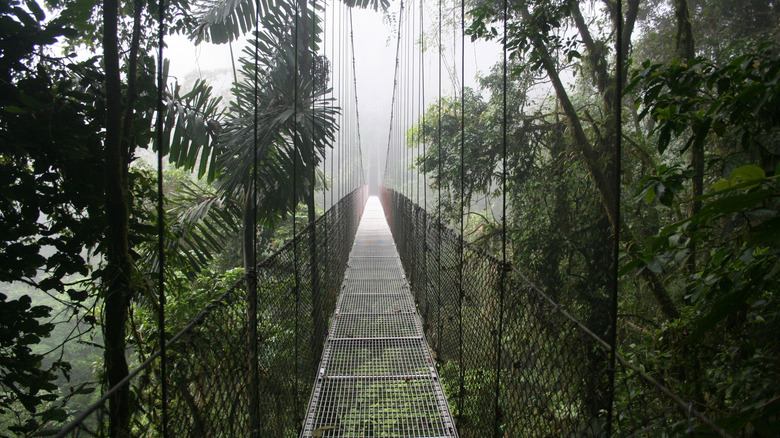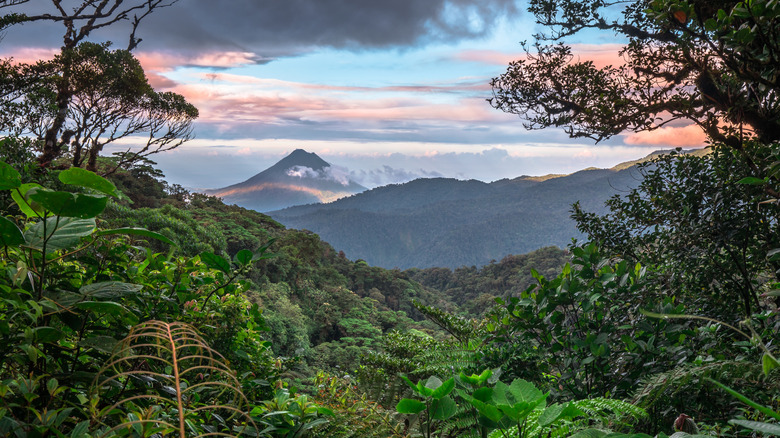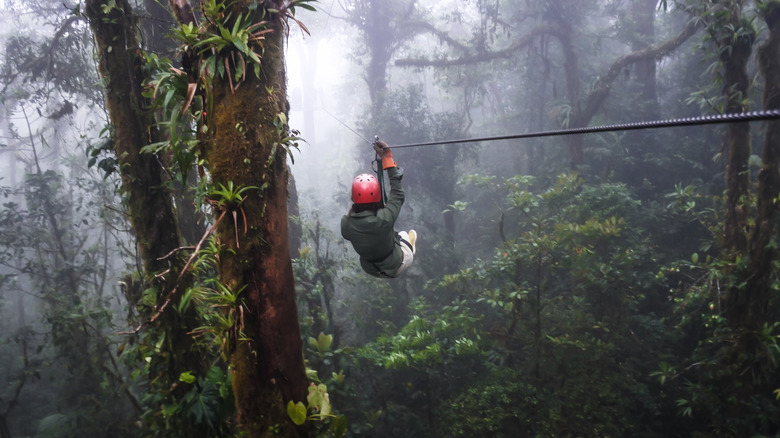A Scenic Costa Rican Region Boasts Lush Cloud Forests & Mesmerizing Hanging Bridges
Who knew the phrase "cloud forest" would be so literal? As you walk across a hanging bridge, your boots clinking lightly over grilled panels, sheets of fog gather all around, obscuring the trees. The bridge sways, but just a little; the many cables keep the walkway steady, and chain-link guardrails rise on either side, preventing any accidental falls. The rainforest hums with natural sounds: insects, frogs, birds, a vast choir of tropical voices. Your forehead bubbles with sweat because the air is so thick with humidity, but it's not sweltering; you're high up in the mountains of Costa Rica, far from either coast, and the atmosphere can feel fresh and even cool. Up here, you can take in the whole rainforest, as if you've transformed into one of the country's 53 species of hummingbird, hovering among the highest branches.
This is a popular experience in Monteverde, a highland community in northwest Costa Rica. With a permanent population of only 6,700 residents, Monteverde is among the most revered destinations in the country, thanks to its dense cloud forests and all-ages canopy tours. Both Monteverde and its neighboring community, Santa Elana, are spread out along curving roads, and the district is geared toward adventurous tourists. Here you'll find a wide range of accommodations — from luxury stays to dirt-cheap hostels — tours for every taste, and more wildlife than you can photograph in a single trip. Monteverde takes a while to get to, due to its remoteness, but for backpackers and families who make the journey, this pristine ecosystem is a dream come true. Some of the best things you can do in Costa Rica can be done here.
Monteverde: From Quaker farms to zip lines and hanging bridges
The town of Monteverde has an unusual origin story: While people have lived in the Tilarán Mountains since time immemorial, the main pioneers in this area came from the United States in the late 1940s. These 44 expatriates were Quaker pacifists who had become disenfranchised with militant U.S. foreign policy and wanted to find a gentler place to live. In 1949, Costa Rica dissolved its military, cementing its commitment to peace and starting a precedent that continues to this day. The Quakers were all farmers, and they set up both a meeting house (equivalent to a church) and the Monteverde Cheese Factory, which recently terminated its tours but still produces some of the best queso in the country.
As Costa Rica's ecotourism industry has exploded in recent decades, so has Monteverde's investment in hanging bridges. Numerous companies have established walkways through the rainforest canopy, along with zip lines, canyoning, and the Monteverde Extremo Bungee Jump, which takes daredevils to a 470-foot platform and drops them into the valley below. The hanging bridges are by far the most universal experience, appealing to adults, children, birders, photographers, amateur botanists, and every kind of nature lover. Here you can search the landscape for 400 avian species, 100 distinct types of mammals, and 120 varieties of reptiles.
Today, Monteverde attracts about 70,000 visitors from around the world each year. You can expect any given tourist to love the environment and geek out about sloths, ocelots, and red-eyed stream frogs. The country's adventurous spirit and environmental stewardship are two reasons Rick Steves considers Costa Rica the ideal escape for burned-out travelers.
How to get to Monteverde
Why isn't Monteverde overrun with tourists? Because it's challenging to get to. Costa Rica has two major airports: Daniel Oduber Quirós International (widely known as Liberia, after the nearest town), a smaller terminal that's popular with beach-seeking tourists; and Juan Santamaría International, a bustling hub just outside the capital city of San José. Either way, you'll have to rent a car or hop a public bus; this will take over two hours from Liberia and nearly 3 hours from downtown San José. The road to Monteverde is well traveled and decently paved, but it's full of steep ascents and dramatic switchbacks, and plenty of travelers will turn to Dramamine to avoid motion sickness. Many visitors face delays during the rainy season as well.
Monteverde is often paired with La Fortuna, a popular town on the other side of the cone-shaped Arenal Volcano. As the crow flies, the two communities are less than 20 miles away from each other, but because forested mountains rise between them, most people drive a meandering, three-hour route to get from one to the other. A traditional — and exciting — alternative is to ride a horse overland from La Fortuna to Monteverde; this guided group tour takes about the same amount of time, but you get to ride into the jungle interior while your luggage is transported separately. This is just one reason you should plan your next family trip to this popular Central American destination for incredible outdoor adventures.


